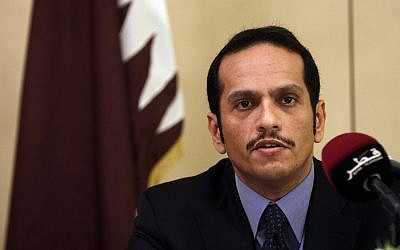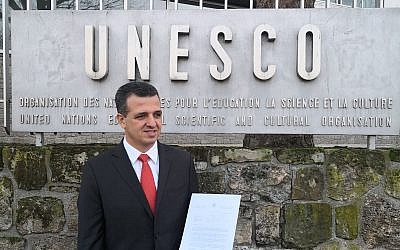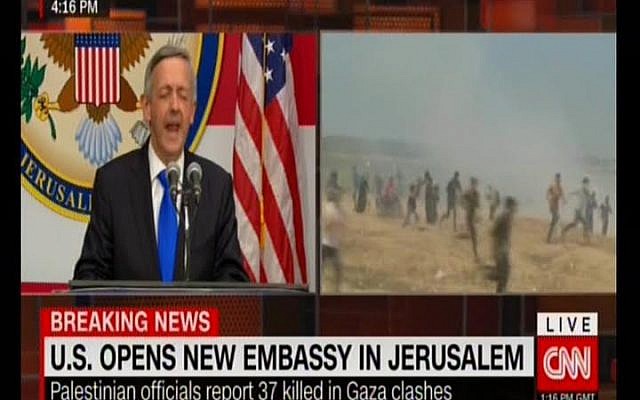Israel’s former ambassador to UNESCO says Netanyahu’s office did not accept the Qatari letter for procedural reasons; ‘the signs were very clear that there was an opportunity here’

Qatar made an attempt to send Israel a proposal to calm the situation in the Hamas-ruled Gaza Strip ahead of the the May flareup in violence, but it ultimately did not reach Prime Minister Benjamin Netanyahu due to procedural reasons, Channel 10 reported Thursday.
According to the report, Qatari Foreign Minister Mohammed bin Abdulrahman al-Thani sent the letter via two close confidants of his, French Jewish businessman Philippe Solomon and Rabbi Avraham Moyal, who in turn approached Israel’s then-ambassador to UNESCO in Paris, Carmel Shama-Hacohen.
The letter presented a proposal to help prevent an expected surge in violence in Gaza surrounding the opening of the US embassy in Jerusalem.
“The Qatari foreign minister put forward a package deal that would have included US, Israel and Egyptian involvement. He said the deal was already agreed by senior Hamas figures including Ismail Haniyeh,” Shama-Hacohen told Channel 10.

Qatar is close to Hamas, but recently has been at odds with other Arab nations including Saudi Arabia. Israel has long-preferred to use Egypt as a mediator with Hamas.
Shama-Hacohen updated the foreign ministry and Netanyahu’s office regarding the letter and was told how to proceed. At one stage Qatar proposed a telephone call between al-Thani and Netanyahu, but Jerusalem refused, instead asking for something in writing.
“The National Security Adviser (Meir Ben- Shabbat) wanted something in print to show they were serious,” Shama-Hacohen said.
Shama-Hacohen then brought the two envoys to Jerusalem with the letter, which they said they had been instructed to give to Netanyahu only. Shama-Hacohen said he saw the letter, read its contents and reported them to Netanyahu’s office.
However, a representative of Ben-Shabbat sent to meet them refused to pass the letter on unless he was allowed to see it.

“The representative of the National Security Council insisted on seeing the letter with his own eyes and was not satisfied that an Israeli ambassador had seen it,” said Shama-Hacohen, who was a political appointee of Netanyahu.
“The Rabbi for his part said ‘here is the envelope, it’s sealed. Your ambassador has seen the letter. The next person to see the letter will only be the prime minister of Israel, because that’s what I promised the Qataris,’” Shama-Hacohen recalled.
The National Security Adviser ultimately did not set a meeting between Moyal and Netanyahu and the letter was never delivered, Shama-Hacohen said, calling it a missed opportunity.
“I believe that this was something that should been pursued and pushed forward and not derailed by procedures,” he said. “I think the signs were very clear that there was an opportunity here.”
According to Channel 10, the deal call for Hamas to end the weekly violent protests that began in March in exchange for investments in infrastructure in Gaza.
Over 130 Gazans have been killed in border protests since March 30, including over 60 on May 14, the day the US moved its embassy. Hamas said 50 of the May 14 fatalities were its members. May 14 was also the eve of “Nakba Day,” when the Palestinians mark what they call the “catastrophe” that befell them with the establishment of Israel.
Most international observers linked the violence to the embassy move, which has angered Palestinians and drawn condemnation from around the world.

Israel says its forces have opened fire to stop attempts to harm soldiers, damage the fence, infiltrate Israel, and attempt to carry out attacks. Israel accuses Hamas, a terror group which seeks Israel’s destruction, of seeking to use the protests as cover to carry out violence.
At least half of those killed since the protests began in March have been identified as members of Hamas or other terror groups.
These clashes have since been followed by two rounds of serious violence in which Palestinian terror groups fired hundreds of rockets into Israel and the IAF bombed dozens of Hamas positions in Gaza.
Israel and Hamas have since reportedly been trying to work out a long-term cease-fire in Gaza.
Last month it was reported that Defense Minister Avigdor Liberman met with Qatari Foreign Minister al-Thani in Cyprus as part of the ceasefire efforts.
The Walla news site said the plane used by al-Thani during his international diplomatic tour in Europe and the United States had made a secret flight from Italy to Cyprus on June 23, while Liberman was in the island nation where he held talks with his Greek and Cypriot counterparts and with Cyprus’s president.
As reported by The Times of Israel
